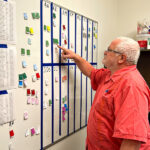
By Laura de Leon
This is the second article in a series about the development of Texas’ Water Conservation and Technology Center. Part I, “Water conservation center fosters collaboration, research” (Feb. 21, 2013) provided an overview of the center’s development, collaborative partners and future opportunities for student research at Texas A&M-San Antonio. Part II, below, is an overview of the center’s projects, including greywater research.
Last spring, Chancellor John Sharp announced the formation of a Texas A&M System center named the Water Conservation and Technology Center based in San Antonio. The goal, according to a university press release, was to “address multiple water issues and develop solutions for Texas.”
The center is focused around finding ways to increase the water supply and water efficiency and is actively involved in diverse projects and collaborations.
The center, biology professor Jose Rodolfo Valdez Barillas, said, is an initiative for the A&M System but is also responding to current environmental conditions, including drought and water restrictions.
Since Sharp made the announcement, the Water Conservation and Technology Center, administered by the Texas Water Resources Institute in partnership with the Texas Center for Applied Technology, has developed plans to involve students from the university to undergo research with the center, starting with a greywater initiative.
Calvin Finch, Water Conservation and Technology Center director, and other collaborators present potential projects to companies and organizations who then either approve or deny.
Companies or private sectors also bring in possible research opportunities. Center collaborators then decide if they are willing and capable of doing the project. Funding for the projects usually come from the company or organization who agree the projects are necessary and want the information being researched, Finch explained.
Finch said the center has proposed about 10 projects; three are currently funded and in development. He said a few were denied, and some are pending.
“Anything that we can do to contribute to better water resources or improvement of technology or application of new technology, that’s part of our goal,” Finch said.
Valdez Barillas, Finch and other collaborators work together and share ideas about what they need to focus on and how students can take part in the research opportunities.
Greywater research
Finch and Valdez Barillas said the greywater initiative is the first center project that may involve students. Greywater is wastewater generated from domestic activities such as laundry, dishwashing, and bathing, and is generally sent down the drain after a single use.
“There’s no reason you can’t use that on landscapes,” Valdez Barillas said in regards to greywater.
Finch said the the greywater research was funded by the Rio Grande Basin Initiative and will occur in two phases.
Phase one is currently in progress at the Uvalde Experiment Station under the direction of horticulturist Raul Cabrera. The experiment station is located in Uvalde, Texas, approximately 82 miles west of San Antonio. The experiment is testing to make sure a number of native landscape plants have a positive response to the use of greywater. Finch said they are going to test plants such as old fashioned roses that are typically grown with low water use.
The second phase developed under TCAT, will take place at the Mitchell Lake Audubon Center located on the South Side of San Antonio, 2.4 miles from Main Campus Building. The plan is to develop a cost-efficient retrofit technique that would alter some plumbing and give access to otherwise wasted water.
Once a working technique is created, the center plans to develop a fact sheet for people to understand how greywater can be used, as well as how they can develop their own retrofit for greywater conservation at their home, or in places of water use.
Finch said greywater use could save about 90 gallons of water per household person, per day. This could save a family of four about 130,000 gallons of water per year.
One area Finch said they will target with a possible subsidy to try and convince small landowners to use the retrofit process is the Edwards Aquifer Region.
He said this will reduce water use from the aquifer and could potentially help protect endangered species identified in the area.
In a storage facility at the Texas Engineering Extension Service on South Presa, Michael Martin, interim director of energy and environmental sustainability at TCAT, explained how the greywater research project will be applied.
On a recent visit, Martin led a student reporter over to a washing machine that will be used in the greywater experiment. The machine will be relocated to the test location where people will bring in their dirty clothes to be washed and the water will be piped over to a garden area.
Martin said they want to see how the plants adapt to the water once the detergent water is used and absorbed. Since people will voluntarily bring in their clothes to be washed for the experiment, Martin said, they will also have a dryer available to finish their laundry.
“With the researchers at the extension service in Uvalde and researchers with Texas A&M, they want to see how well the plants germinate with the greywater,” Martin said.
The experiment will reflect a residential atmosphere and the researcher will document how many loads were washed, and in what timeframe. With this data, he said, they will be able to determine how well the plants are reacting with the greywater.
“It’s all about using water that normally you would get rid of––waste,” he said.
The experiment will also include another garden bed treated with potable water. Martin said they will use the same amount of water used in the greywater beds to compare the growth rate.
Current Projects: Regional Water Conservation Program
Finch said the center’s major funded water project is the Regional Water Conservation Program in the Edwards Aquifer Region. The center was selected to implement the program by the Edwards Aquifer Authority because of the expertise of its staff and its long time involvement, according to the program fact sheet.
“They believe the plan is sustainable, will stabilize the availability of water resources from the Aquifer and will protect the endangered species at Comal and San Marcos Springs.”
The researchers are attempting to save 20,000 acre feet of water in the region, half of which is going to stay in the aquifer to protect the endangered species at the springs.
“We are coordinating $1,900,000 programming in just that project,” Finch said.
Finch said in a Feb. 11 interview that San Antonio has been very successful with water conservation and the city has not used any more water now than in the 1980s despite a population of increased by 400,000.
Another project the center hopes to be involved in the coming year, Finch said, is to understand how to use brackish water from the Edwards Aquifer.
East Wildlife Foundation Water Mapping
The center’s hydrogeologist, Kristine Uhlman, is currently working on a project that will map the East Wildlife Foundation’s water resources. The foundation’s mission is to support wildlife conservation and other public benefits of ranching and private land stewardship, according to their website.
Alfonso Ortega-Sanchez, wildlife and research manager at the East Wildlife Foundation said the foundation wanted to have the knowledge and know what specific resources are available across their 216,035 acreage.
“With cattle and wildlife, it’s something that is absolutely necessary,” Ortega-Sanchez said.

Finch said the project was proposed and funded by the foundation because they wanted to use Uhlman’s skills to obtain more information about their resources. Uhlman just returned from visiting the East Wildlife Foundation located in South Texas where she utilized their land model that already exists. This information, Finch said, will help them when they put together a plan to protect and utilize their resources.
This may potentially develop into a bigger project, Ortega-Sanchez said, explaining that it will be determined after they analyze the information provided by the center.
Center priorities: water conservation projects
A project funded by the San Antonio Water System, was conducted by the center to see if there are any ways to save energy and reduce costs in the water production process.
The research was conducted in San Antonio and researchers are currently examining the preliminary report. According to Finch, the results showed there were many potential ways to save costs and he said both parties, the center and SAWS, were excited about the results.
At this time, the center is discussing the results with SAWS. The next step is for SAWS to decide if they would like more research to be conducted or if they are content with the information provided.
“We are not at liberty at this point to talk about specifics until SAWS decides what they want to do,” Finch said.
Center Proposal
A Hydraulic Fracturing Communications and Research project, proposed by the center, could provide “enhanced communication and information” within the oil and gas industry. The project contains 11 components and is organized into three groups including communications, technical and planning, and education.
One component, the Fracturing and Water Quality Support, is geared toward keeping a standard water quality analysis. This will explore the concerns from small communities and individuals who are worried about the impact on their well water quality with the fracturing activities close by. The center plans to work with local analytical laboratories and provide a standard test kit at a lower rate than if an entity contacted the laboratory directly.
The Eagle Ford Hydraulic Fracturing Area Water Supply is another component of the project that would make sure the short-term, high volume water supply in fracturing areas are adequately supplied when necessary. This would offer fracturing contractors, landowners, groundwater districts and other stakeholders a service which would meet the needs for all parties involved and prevent water conflict.
Finch said the education group portion of this project is directly aimed toward the involvement of A&M-San Antonio students. Since the hydraulic fracturing industry is a major part of the economic and social activity in the Eagle Ford region, the center suggests it should be part of the education curriculum.
As the center develops, Finch said, the center will try and become involved in as many projects as possible and achieve their goals. As student opportunities become available, the center and the university will provide information and applications to potential candidates.
For more information about the center, visit the website.





